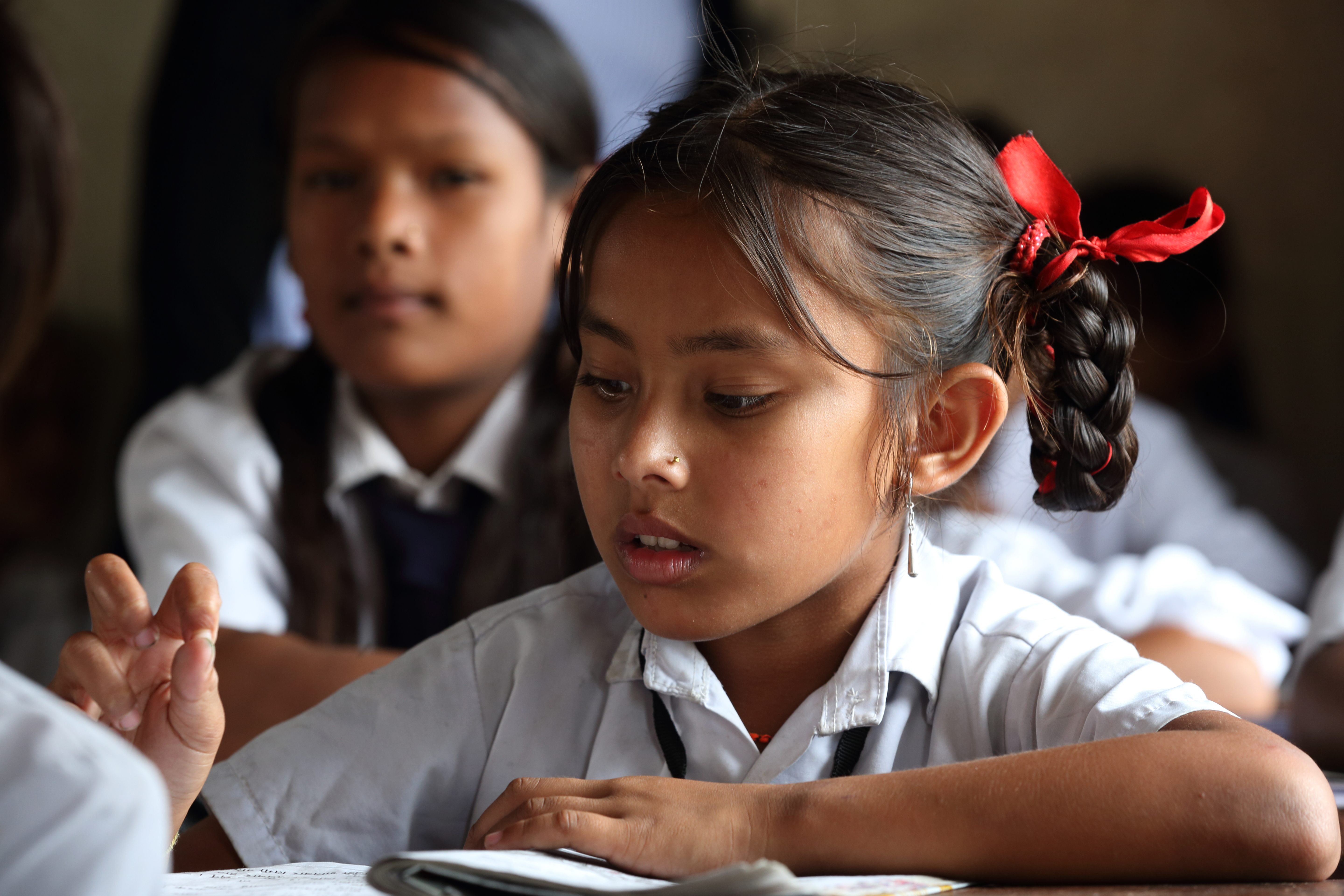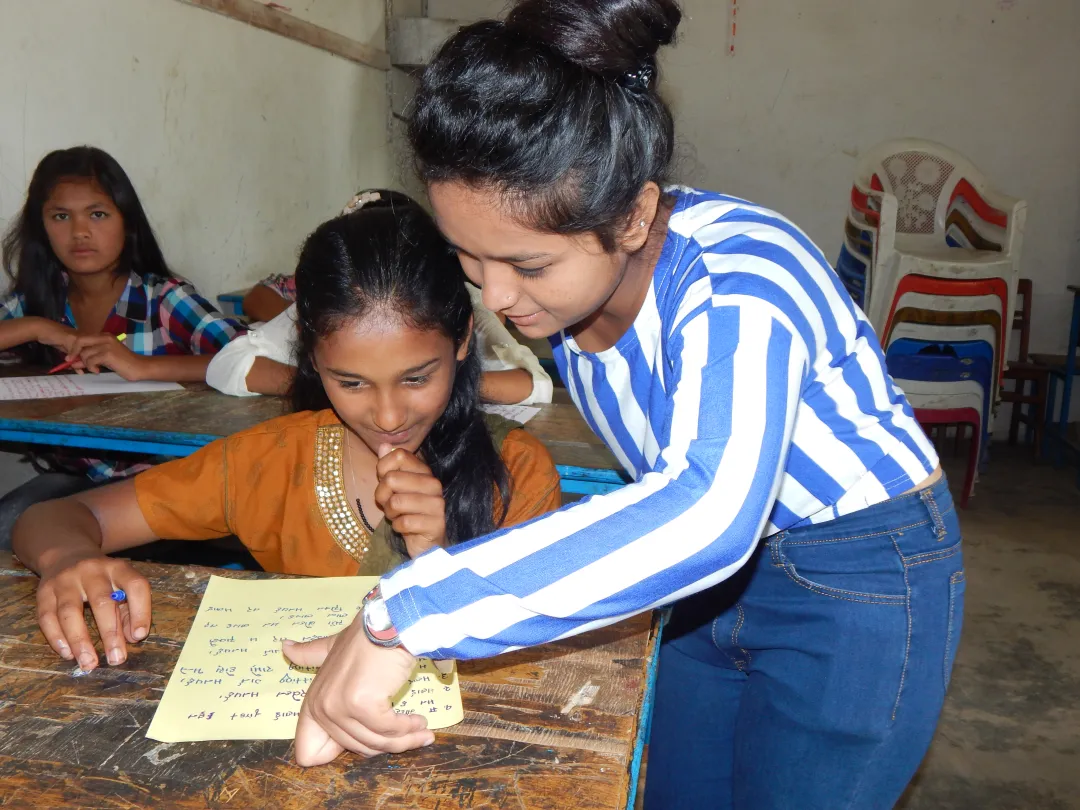Globally, the attention is slowly steering towards Information and Communication Technology sector that promises both local opportunities and international relevance. However, Nepal’s journey toward digital transformation remains incomplete. It remains a distant reality for many Nepali girls, particularly those from rural areas and public schools.

May 16, 2025

AI generated image of young students attentively writing in their notebooks during class.
Photo: Freepik AI
Dreams are often shaped by what children see around them: doctors in white coats, engineers with blueprints, or pilots soaring through the skies. These professions have long symbolized success. Yet today’s world looks very different from even a decade ago. As technology becomes central to how we live, learn, and work, young people are finding inspiration in screens, software, and innovation.

A Young Nepali Girl Immersed In Her Book.
Photo: Wikimedia Commons | Department of Foreign Affairs and Trade
This global shift is slowly steering attention toward Information and Communication Technology (ICT), a sector that promises both local opportunities and international relevance. However, Nepal’s journey toward digital transformation remains incomplete, especially for girls. While the digital landscape is expanding, it remains a distant reality for many Nepali girls, particularly those from rural areas and public schools.
Limited early exposure, unequal access to digital tools, and a curriculum that treats computing as optional leave girls behind before they even begin. As they grow older, women continue to be significantly underrepresented in Nepal's ICT workforce.
|
[box-content-ad-1]
|
In 2024, Women in Information Technology (WIIT) published a report titled Barriers to Breakthroughs: Women in Nepal’s Information and Communication Technology Landscape. The report stated that from the data collected, women make up only 7.88% of staff in ICT companies and a mere 0.51% in ICT-enabled firms, with just 19.55% of them holding managerial positions. The report is based on data from 402 ICT companies, 400 ICT-enabled companies, and 430 women professionals.

AI-Generated Image Of Highlighting The Potential Lack Of Girls In ICT.
Photo: Gemini AI
But as highlighted by the WIIT report, it is not an isolated issue. This underrepresentation is deeply connected to the trends observed in higher education as well, where the number of female students enrolling in ICT-related degree programs also remains significantly low.
Elisha Rajbhandari, COO of Sciever Inc., sheds light on the academic instability in the women pursuing ICT degrees in Nepal. Reflecting on her research for the report, she notes, "We found out that if there is a significant intake in one year, the intakes significantly drop in the next year which hampers any progress we see in the numbers."
If one goes back even further to analyze this trend, Usha Adhikari, Senior Program Officer of Rukmini Foundation, states, “Foundational gaps in primary and secondary school [to pursue STEM and ICT-related subjects] significantly deter girls from pursuing ICT later."
Highlighting this lack of encouragement, Minu Pradhan, former Director of Nepal Telecommunications Authority, emphasizes the need to "teach girls that ICT is not a 'hifi' [difficult] topic". She says that due to this conditioning, even high-achieving female students sometimes avoid STEM or ICT, indicating that the broader societal or educational environment is as important in nurturing their interest and confidence.
The lack of early encouragement for girls in ICT is worsened by insufficient school-level intervention, even more so in rural Nepal. In areas with limited access to technology, girls face even greater barriers to exploring ICT.
Gunakeshari Pradhan Manandhar, Former Director of Nepal Telecom and Chairperson of WIIT, points out that "financial challenges in providing resources like laptops and mobile phones to students from less privileged backgrounds disproportionately affect rural girls," widening the digital divide. While Pradhan observes increasing technology availability, a gap in consistent access to quality resources and trained educators persists.
Manandhar also notes that the lack of family support and conventional societal norms also add to this problem. Pratiksha Pandey, CEO of Smart Cheli adds her observation that these "societal stereotypes" cause a decline in girls' interest in STEM, between the 13-17 age group, especially in rural communities. With less exposure to diverse perspectives and fewer female STEM role models, traditional gender roles can be strongly reinforced.
Elisha Rajbhandari, who has worked extensively to train young girls in STEM, observes a persistent challenge: the lack of visible female role models. This, coupled with societal expectations and unsupportive workplaces, leads to higher attrition and discourages women from entering ICT companies. Those who do join are frequently "concentrated in non-technical departments."
To address these multifaceted challenges, several grassroots-level initiatives are already in motion across Nepal.
Notable among them is the Rukmini Foundation’s ‘Didi Mentoring Program’ and ‘Grow Clubs’, where young girls engage with female mentors and receive basic computer training.

Rukmini Foundations' Didi Program Mentor Helping Student.
Photo: Rukmini foundation
Similarly, Pandey’s Smart Cheli focuses on early STEM engagement (ages 10-18) through playful learning, intensive programs like STEAM AdhyayanShala, STEM mentorship, and workshops, including coding summer camps, aiming to counter stereotypes and build future female STEM leaders. Adding to this landscape of impactful educational initiatives is Karkhana, which transforms education by providing hands-on STEAM learning experiences in school settings and kits for students, coupled with essential training for teachers.

Smart Cheli Stem Adhyanshala
Photo: Smart cheli
Women in Information Technology (WIIT) also has conducted outreach programs to raise awareness, trains ICT teachers (especially in rural areas), organizes events like the Girls in ICT Day walkathon, and provides practical skills workshops in cybersecurity and robotics across various districts. WIIT aims for sustained impact through long-term, structured one-day to week-long national-level training programs specifically designed for girls, while also advocating for strong government support and targeted policies.

Women in Information Technology (wiit)walkathon For Girls in Ict
Photo: Women in information technology (wiit)
Women Leaders in Technology (WLiT) are actively working to address these challenges by providing essential digital literacy, leadership training, and mentorship.
Despite the dedication and success of these localized initiatives — some of which have been running for years — the overall representation of women in ICT education and the workforce remains low. The interviewees voice unanimously that they have created a spark, now to convert that spark into a fire, it needs more than just short-term, small-scale and scattered individual efforts, we need a consistent effort from everyone.
There is a shared consensus: Nepal now needs a broad, coordinated, and government-supported national strategy. Only through such unified, systemic efforts can the impact of grassroots programs be amplified, ensuring lasting change and meaningful gender inclusion in the country's digital economy.
At an international conference held last week, Prithivi Subba Gurung, Nepal’s Minister of Communications and Information Technology, reaffirmed the government’s commitment to building an inclusive IT ecosystem. He emphasized the transformative potential of IT and data science for Nepal’s development, stressing the crucial role of Nepali girls and women in shaping this digital future.
However, achieving inclusive digital transformation for Nepali girls in ICT requires more than goodwill — it demands a multi-pronged, sustained, and systemic national approach. The insights and experiences shared by educators, policymakers, and grassroots leaders highlight critical areas where urgent intervention is needed.
A foundational recommendation centering on policy-level interventions is required. Gunakeshari Pradhan Manandhar and Minu Pradhan strongly advocate for making ICT a compulsory subject beyond primary school, ensuring early and equitable exposure for all girls, regardless of their geographic location. This must be coupled with targeted programs and increased investment in ICT infrastructure and qualified teachers in rural schools.
Manandhar’s early encouragement in mathematics from teachers also played a significant role in her path. She highlights this disparity, stating, "In some rural areas, there is only one teacher of computer or even none."
This teacher scarcity is compounded by the curriculum itself, as Minu Pradhan points out, "There are no IT compulsory subjects in schools." Schools in remote areas have less incentive to hire and retain dedicated computer teachers, she adds.
Targeted scholarships specifically for ICT and STEM fields, with a focus on reaching girls in underserved rural communities, can break down economic barriers and open pathways to education and future careers. Its catalytic role cannot be overstated.
Minu Pradhan’s journey underscores this powerfully. Her access to engineering was directly enabled by a government scholarship, leading her to assert that "scholarship should be a major investment from the government and should work on it, which helps those who cannot afford it."
Creating a supportive ecosystem that nurtures girls' interests from a young age is paramount. Usha Adhikari’s experience highlights the critical need for "more local-level programs, STEM clubs, and training opportunities to spark their interest and show them the possibilities" early on. Similarly, Elisha Rajbhandari’s early interest in mathematics and science, nurtured by support, underscores the importance of fostering these foundational subjects from school.
Addressing systemic workplace barriers is key to retaining women in the ICT workforce. Pradhan suggests introducing tax incentives for companies that prioritize the recruitment and retention of female employees. Meanwhile, Pandey stresses the importance of community and parental involvement to foster supportive attitudes and dismantle long-standing gender norms.
Ultimately, empowering Nepali girls in ICT demands a unified and sustained commitment from families, educators, NGOs, the government, and the private sector in Nepal to dismantle barriers and cultivate a truly inclusive digital future for Nepali girls.

By sharing valuable information and sparking inspiration, we aim to foster growth, innovation and brighter opportunities for future generations.
Contact us